These days, suitable resources are sadly often scarce in companies. In this environment, capacity planning in project management helps obtain or create the necessary capacities in the form of suitable employees at all times. In doing this, you have to constantly look ahead. At the same time, you must consider the company’s strategic goals – the basis for corporate success.
How do you establish capacity planning in project management and master the challenges? In this article, you will learn how to succeed in capacity planning with practical tips. Here is what is waiting for you:
- Capacity planning definition
- Benefits and risks of capacity planning in project management
- 4 steps to successful capacity planning in project management
- Findings of the PMO Survey 2020 regarding capacity planning
- Conclusion and checklist: Capacity planning in project management
Let us begin!
Capacity Planning Definition
Strategic capacity planning is concerned with the predictive provision of appropriate resources in the form of employees with the necessary skills. It must ensure that appropriate employees can implement strategically relevant projects at the right time.
The terms “(strategic) capacity planning” and “strategic resource planning” are synonymous.
The tasks of capacity planning in project management are usually taken on by portfolio managers or the PMO in coordination with project managers (requirements regarding skills) and team leaders (overview of available resources). The below graphic highlights the responsibilities of the roles in the project environment of a company.
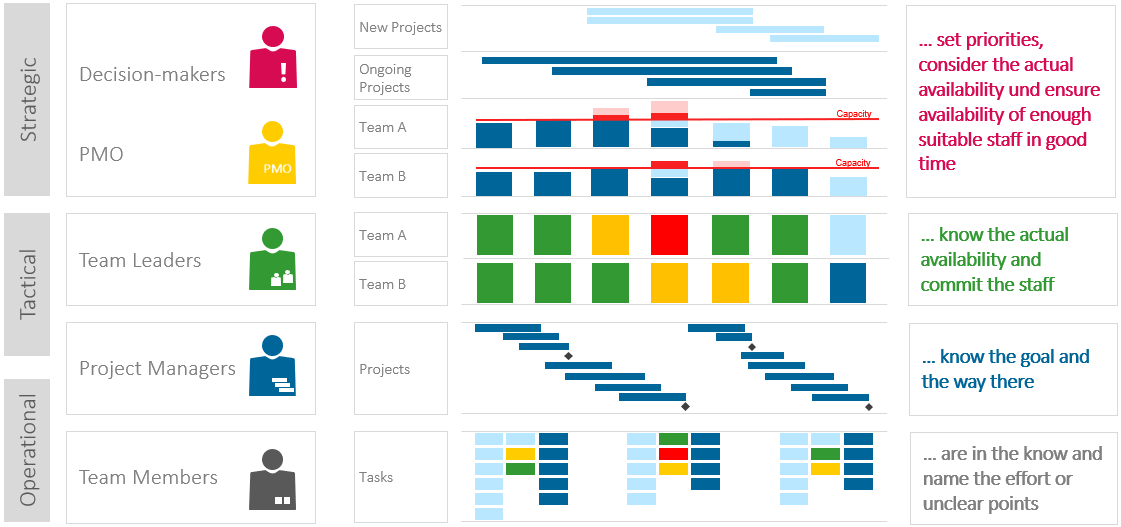
Special Download: Capacity Planning – 4 Important Success Factors (PDF file)
Please fill in the form.
* Required Fields | Data Protection
Benefits and Risks of Capacity Planning in Project Management
Capacity planning can yield multiple benefits. With capacity planning, you:
- Make sure you reserve the most resources for the most important projects – rather than for unimportant ones
- Obtain a complete overview of all resources and their assignments to projects and basic load; this will keep you informed about the overall resource utilization at all times
- Know which additional projects you can start and carry out
- Identify resource bottlenecks in good time and are able to react to them according to corporate strategy
- Avoid resource conflicts, as they do not even arise
Inadequate capacity planning, on the other hand, carries numerous risks:
- Due to inadequate resource allocation, projects are not finished on time
- Project costs rise, as there are too few appropriate resources
- Some business opportunities you cannot exploit, as you are unable to obtain the required skills in good time
- Your coordination efforts for resolving resource conflicts are strikingly increased
All of this can result in dissatisfied customers, hence the importance of capacity planning!
4 Steps to Successful Capacity Planning in Project Management
And this is how you reach your goal of successful capacity planning in four practical steps:
Step 1: Necessary Processes with the Right Staff
The strategic planning of capacities depends on:
- Dynamics at your company
- Your industry
- Number of projects
- Number of resources
- Duration of projects
Different companies tend to undergo the strategic process of capacity planning at different intervals:
- One to four times a year for companies developing and making products
- Possibly monthly for companies offering services
- Only on occasion for companies planning few major projects
Those involved in the strategic capacity planning process are:
- Management with strategic targets
- Team leaders and heads of department who have to provide resource information
- Project managers who have to update ongoing projects by the due date
- PMO preparing new projects properly and controlling the overall process of capacity planning

Make sure all data are complete and up to date by the due date. For this, all involved have to pull together in unison.
To achieve this, you need a PMO that has the relevant competencies.
The PMO:
- Defines processes
- Trains the people involved
- Motivates them to perform their tasks in good time
The PMO may also support the project managers and team leaders in executing their tasks. This depends on the type of PMO you have.
Our tip: For successful strategic capacity planning, it is vital to have the support of a strong PMO with backing from top management.
Read this to find out more: PMO Setup in 4 Simple Steps
Promote the benefits of cyclical coordination (at set intervals) to all participants. This will motivate them to get involved. It is crucial to fix the intervals for coordination individually. They depend on your company’s possibilities and necessities.
Moreover, you have to be minute in defining how to prepare as well as conduct planning and decision meetings.
You have to manage to make all relevant decisions in a matter of hours. At the same time, the decisions on project starts and resource availability need to be well founded. This will only work out if you have a clear agenda and stringent moderation in the context of a regular project portfolio meeting.
Our tip: See to the publication of the results of the project portfolio meetings. Employees tend to expect a lot from the PMO’s work and its controlling influence in the interest of better employee capacity planning. This is where there is a lot of potential for good news. If you sell it well.
Special Download: Resource Planning Software for the Roles Involved (PDF file)
Please fill in the form.
* Required Fields | Data Protection
Step 2: Complete and Up-to-Date Project Data
First, you register all projects with the essential information in a central database. This requires details such as:
- Name
- Project manager
- Sponsor
- Start
- Finish
- Traffic light indicators for status and resource requirements
For ongoing projects, the realistic remaining effort is most relevant – based on the current situation.
For new projects, it is necessary to meet the minimum requirement for resource planning. This means you have to plan all required skills – not necessarily people – per month or quarter.
It is definitely not enough to look only at the total work without the distribution over time.
This is exactly where it starts to get complex.
Find out your optimum specificity by beginning with the roughest possible but still complete planning.
Everyone asks for detailed planning, as it appears to be the better basis. But consider that this requires a higher planning effort. This effort will have to be made again and again in the future.
Our tip: Find out your optimum specificity. What is important above all is complete planning.
If there are more project proposals than the company can carry out, you need to prioritize them. This allows you to decide which new projects you can start.
There are various methods of prioritizing. They can be suitable to a greater or lesser extent – depending on the number of projects and decision-makers.
You might also like our Project Portfolio Management 7-Step Guide.
Eisenhower’s rating according to importance and urgency is one way. It will help you to get good results quickly.
But the easiest way is to make the decision-makers prioritize the list of new projects.
Our tip: Turn to the relevant decision-makers when determining weight and urgency of the projects.
If there are many decision-makers as well as many projects, you might have to consider a different course. You might need to create strategic drivers. These have to be prioritized and weighted and assigned to the projects accordingly. This will allow the system to calculate the prioritization.
Check on all accounts if the most effort is going towards the most important projects.
Here is how you do it: You align the importance of the drivers with the corresponding efforts of the assigned projects.

Identify unimportant projects it might be best to stop. This can liberate resources for more important new projects.
Observe the dependencies among the projects, too. Some development projects can only start once the results of basic projects are available. Maybe, you have also planned several alternative scenarios. Naturally, only one of these needs to be implemented.
Simple Excel lists soon prove to be inadequate when it comes to prioritization and dependencies. Professional capacity planning tools provide excellent support for these challenges.
Our tip: When implementing new kinds of projects, e.g. in the R&D area, you often face unknowns or various approaches to a solution. Resource requirements tend to be relatively uncertain or rather different from case to case. We recommend you to divide such projects into research and implementation. This allows you to limit the uncertainty in the research part via a time budget. Based on the results of the research you will be able to plan the implementation part anew and in a more precise way.
Further reading: PMO Tools for Successful Multi-Project Management
Step 3: Identify the Actually Available Capacities
It does not make sense to analyze each person individually. While this would be desirable, it would be too much effort. It would be confusing, too.
Displaying the total capacity of all employees in one chart is not wise either. Employees have different skills which you have to deploy as required.
A clear and sensible level of detail can be obtained by consolidation at skill level. Some companies also form teams according to skills. In some circumstances, this permits planning at the level of these teams. In most cases, this is easy to implement.
Read this article to find out about using skills management in resource planning.
The level of detail regarding the skills should bear relation to the effort. The capacity plan must remain easy to understand at all times. The above principle also applies here: as rough as possible, as detailed as necessary.
Moreover, you have to use the actual availability for projects in your calculations. There are two options to achieve this:
- You deduct basic load or absences and operations from the total resource capacity
- You compare the basic load and the projects with the full capacity
This is ultimately a matter of tools and the decision-makers’ taste.
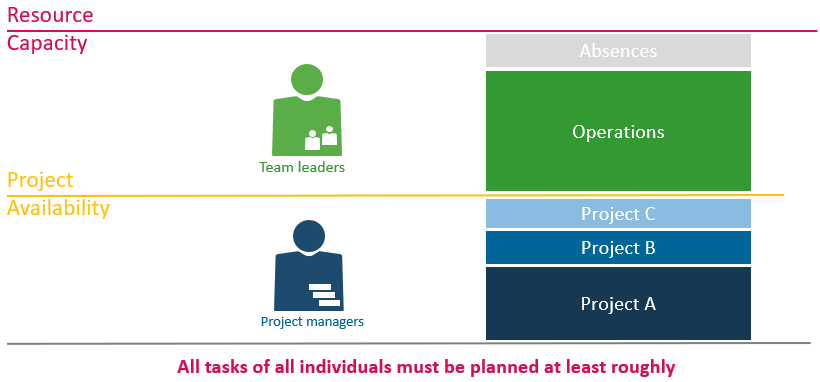
How the basic load or operations are dealt with is an important factor for planning precision. To keep it simple, you can use a flat estimate across the entire year.
But it is preferable to retrieve the team leaders’ planning on a monthly basis.
Our tip: Be sure to involve the team leaders in your project capacity planning. Provide them with a suitable tool for tactical resource planning. The tool should be capable of transferring the team leaders’ data to the project and portfolio management system. Team leaders have an interest in planning all activities outside of projects anyway. It can be simple to transfer their data from Excel into a professional tool.
Reading tip: 6 Steps to Resource Management: Introduce Tactical Resource Planning
Free Download: How to Manage Tactical Resource Management (eBook)
How you make resource coordination between project and line management work smoothly: lots of practical tips and checklists on how to set this up quickly yourself (Processes & Tools).
Step 4: Consolidate Capacities and Requirements
Both the capacities for the skills and the requirements from the projects are at hand. Now, you have to examine how these fit together.
Find out about 7 success factors for multi-project management here.
In order to control them, all skills and their utilization have to be viewable on one page in an appropriate way. After all, a project usually involves various skills.
With every change you make, the effect on all skills should be visible at once. This requires the appropriate resource diagrams showing multiple skills on one screen.
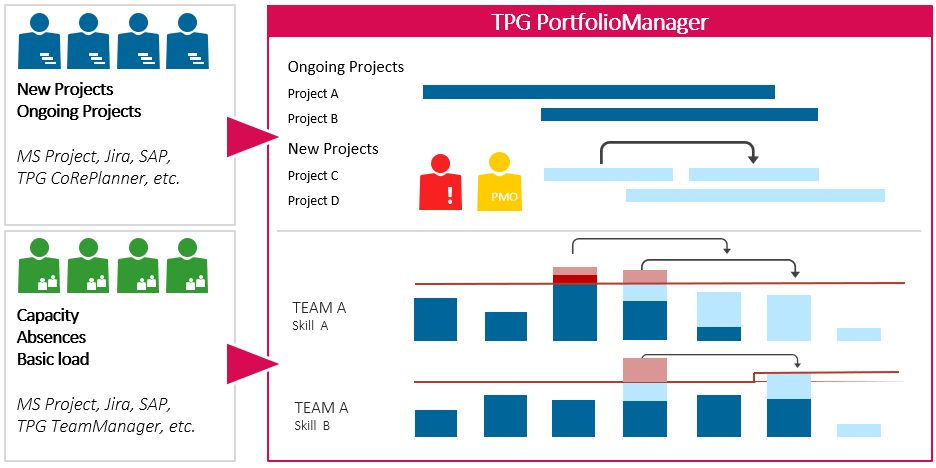
When you add new projects to the portfolio, this has to be in line with the priority and the remaining availability.
Your approach has to be similar to filling a glass with stones and sand. You add the large stones first, then the pebbles and at last the sand. Shaking and rattling helps the sand to fill all the gaps.
You may have excess capacity for some skills. In this case, identify tasks for the sales department or product management. Or you might identify potential for retraining. In times of ever-changing environments, this is a valuable insight – if it comes at the right time.
A more common problem will be resource or skill overload. There are some simple and logical ways of resolving these:
- Compensate for the missing capacities with the aid of internal or even external resources
- Change the priority of the projects or drop some projects altogether
- Postpone the projects far enough into the future that they fit into the given resource situation
For all three options, you will need an optimum database at any rate.
But always be aware that the database is based on personal estimates. And that it is exposed to political currents.
There is one difficulty you will face time and again when communicating about the workload of the teams. You have to make it clear to all involved that the glass is full and nothing new can be taken on.
Learn more about Project Resource Planning – Basics and Methods here.
One trick:
Ask this simple question: what can we remove to make room for the new? This will create the necessary awareness among all stakeholders.
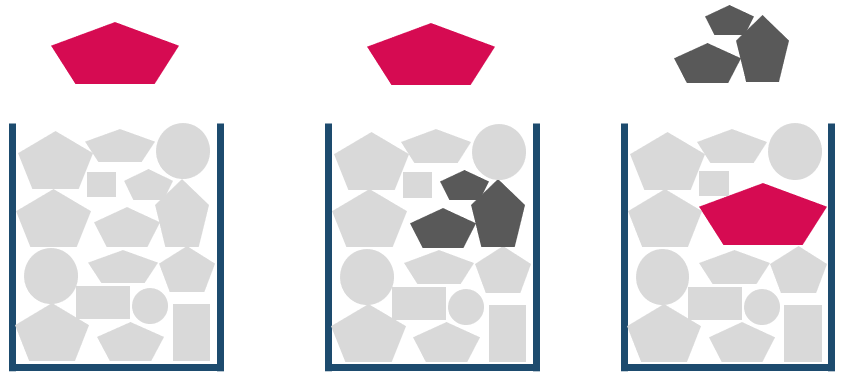
You could also ask what part of “no” they did not understand.
But enjoying a drink together can also help. This will relieve pressure and improve the atmosphere. After all, there is always room for this in a glass filled with stones, pebbles and sand 😊.
Reliable Data Is the Basis of Successful Capacity Management
No matter whether they are about bringing in external resources or postponing projects: the decisions remain human decisions. But you should always make these decisions based on the best possible data.
To obtain this data, you need suitable software tools for capacity planning. Without the appropriate portfolio management software support, which also helps with strategic resource planning, you will find the tasks involved hard to master.
Are you working with tables in Excel or something similar? Are you dealing with a certain degree of complexity and amount of data? In this case, you will only achieve the best outcome in capacity planning and decision-making with a lot of effort – or not at all.
Our tip: Define your precise objectives and requirements before investing in a tool. Plan a phased introduction of the tool to avoid overwhelming those involved. Only then does the purchase make sense. And you are on the right path to higher resource efficiency.
Reading tip: Requirements for resource planning software for the roles involved
Findings of the PMO Survey 2020 regarding Capacity Planning
In the context of a comprehensive TPG Survey on the state of the PMO, we derived an interesting result from the responses of 330 companies with a PMO.
Learn more about the challenges of project management resource planning – capacity planning as well as tactical and operational resource planning.
Companies that can be classed as high and top performers have implemented strategic capacity planning much better than low performers. In the case of the low performers, strategic capacity planning almost does not feature among the responsibilities of the PMO.


In addition, top-performing companies were half as likely to name lack of resources as a reason for unsuccessful projects.
The top performers did not name insufficient staff qualification as a reason for unsuccessful projects either. This was because they are clearly better positioned in terms of skills management than the other performance levels.
What we can take away from this: strategic capacity planning and good skills management clearly pay off in the pursuit of project success.
Conclusion and Checklist: Capacity Planning in Project Management
This article has introduced four important steps to successful strategic capacity planning:
- Step 1: Establish all necessary processes with the appropriate staff – from top management and the PMO to team leaders, department heads and project managers.
- Step 2: Provide for complete and up-to-date project data and prioritize your projects.
- Step 3: Identify the capacities that are actually available at skills level. To do this, define the basic load and confer with the team leaders at regular intervals.
- Step 4: Consolidate the requirements (step 2) and the capacities (step 3). Identify underload as well as overload and try to balance them.
In addition, you have learned about two further important parameters. These can make for successful resource capacity planning in project management:
- An efficient PMO with backing from top management
- A suitable software tool to provide a solid database
Find the most important points summed up in the following checklist:
Checklist Capacity Planning in Project Management
- Appoint a PMO with the appropriate competencies
- Identify the roles and persons involved
- Promote the benefits of strategic resource management
- Warn stakeholders of the risks of going without capacity management
- Ensure a coordination process with meetings at set intervals
- Keep all ongoing and new projects up to date
- Control the priorities of the projects
- Consider the dependencies between the projects
- See to complete planning by the team leaders, i.e., team capacity planning
- Be exact in preparing and conducting planning sessions
- Create a clear overview by means of a dynamic chart with project lines and resource diagrams
- Introduce the topic step by step to avoid overwhelming those involved
- Provide each role with the appropriate IT tool
Our final tips
Get to know the individually adaptable “PPM Paradise” – the optimal environment for your enterprise-wide project, program, portfolio and resource management. Download the eBook now (just click, no form).
And sign up for our bi-weekly blog newsletter to make sure you receive all our updates.
Is there anything you would like to add regarding project capacity planning? What gives you a headache? We’ll be happy to respond to your comment below.
Subscribe to TPG BlogInfo: Never miss new practice-oriented tips & tricks
Every other week: Receive practical tips in TPG blog posts written by recognized experts in project, portfolio, and resource management.
* Required Fields | Data Protection
 Johann Strasser
Johann Strasser
Managing Partner at TPG
The certified engineer, has been a managing partner at TPG The Project Group since 2001. After many years as a development engineer in the automotive and energy sectors, Johann Strasser spent a decade as an independent trainer and consultant in the field of project management. During his tenure, he also served as project manager for software projects in the construction industry and provided scheduling and cost management support for large-scale construction projects. At TPG, he applies his expertise in product development and consulting services for international clients. His special focus is on PMO, project portfolios, hybrid project management, and resource management. For many years now, he has shared his knowledge through presentations, seminars, articles, and webinars.
Read more about Johann Strasser on LinkedIn and XING.
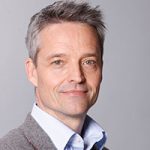 Achim Schmidt-Sibeth
Achim Schmidt-Sibeth
Senior Marketing Manager
After earning his engineering degree in environmental technology, he gained many years of experience in project management through his work at an engineering office, an equipment manufacturer, and a multimedia agency. Achim Schmidt-Sibeth and his team have been responsible for marketing and communication at TPG The Project Group for many years now.










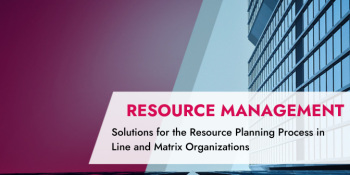
5 Comments
Thanks for such an informative article–I think this is a really informative and helpful guide for capacity planning, especially when just starting out with a PMO. I particularly appreciated the checklist at the end–I think any resource manager would make good use of it :).
As a complement to this piece, I’ve written about how capacity planning is changing in 2019 given new HR and project management trends–I imagine it might be interesting to folks who also enjoyed this article. Check it out here: https://blog.resourceguruapp.com/6-major-factors-affecting-resource-capacity-planning-in-2019/
How do you plan the material requirements and their availability on the site when you have to deliver a “construction” Project on time” ? It can become much more complex than the “renewable” resources (labor, etc) constraint. which is often and more and more solved using the “stupid simple” SCRUM (and sprints) solution…
Nice information, valuable and excellent work, as share good stuff with good ideas and concepts, lots of great information and inspiration, both of which I need, thanks to offer such a helpful information here.
Thank you very much! If you have any tips or questions regarding the topics on this blog, feel free to contact us. Please understand, that we dont publish links to commercial offers in comments. Best Regards Tina
great content; well written article